

|
Hello from the Wine Tastings Guide!
This is The Poor Man's Guide to Fine Wine™, a monthly newsletter on all things wine and your guide to finding great wine at affordable prices! Each issue brings you articles about goings-ons in the world of wine as well as reviews of inexpensive wines. If you like this newsletter and our website, please forward this email to someone you know who enjoys wine or wants to learn more about wine and wine tastings. If this was forwarded to you and you like what you read, you can subscribe to The Poor Man's Guide to Fine Wine for free now. If you have suggestions, questions, article requests or comments, please contact me -- I love to hear from my readers!
Contents of this issue of |
|||||||||||||||||||||||||||||||||||||||||||||||||||||||||||||||||||||||||||||||||||||||||||||||||||||||||||||||||||||||||||||
| Zero Stars | A wine I don't particularly recommend. |
|---|---|
One Star |
Well made, simple and tasty wines that I recommend. |
Two Stars |
Excellent quality. Worth an extra effort to search out and enjoy. |
 Three Stars |
Outstanding wine of the highest caliber. |
| + Plus |
Either a wine that is close to deserving a higher score or a wine that may not be showing that much but with the potential to move up in quality with further aging. A young wine that may be closed up or shows potential for significant improvement. Assuming it opens and improves with additional age, it may merit a higher rating. |
| ??? | Flawed bottles or wines that are difficult to assess for any number of reasons. Judgement reserved. |
Sparkling Wines:
| C et P Breton Vouvray Pétillant "La Dilettante" |
Drink Now-2013 | $17 | |
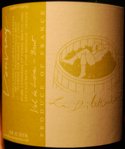 The Bretons are known most for their Cabernet Franc-based wines from Bourgeuil and Chinon. Which is funny because "Breton" is one of the local names for the Cabernet Franc grape in the Loire Valley! Their reds, also imported by Kermit Lynch, are also lovely and worth a search. This is a sparkling white, made from the Chenin Blanc grape from the village of Vouvray down the river a bit. Sparkling Vouvray can vary quite a bit, some being kinda simple and sweet without much interest. However, the best can be lovely sparklers with racy acidity and vibrant fruit. This is one of the later! The Bretons are known most for their Cabernet Franc-based wines from Bourgeuil and Chinon. Which is funny because "Breton" is one of the local names for the Cabernet Franc grape in the Loire Valley! Their reds, also imported by Kermit Lynch, are also lovely and worth a search. This is a sparkling white, made from the Chenin Blanc grape from the village of Vouvray down the river a bit. Sparkling Vouvray can vary quite a bit, some being kinda simple and sweet without much interest. However, the best can be lovely sparklers with racy acidity and vibrant fruit. This is one of the later!Fresh and mouthwatering tangerine and grapefruit open your eyes. Your mouth is not disappointed with delightful, fun and lively fruit that simply mouthwatering and delicious. This is great fun and quite low in residual sugar so this could do quite well either as an apéritif or with a variety of foods. Great value sparkler! One Star Plus. Importer: Kermit Lynch Wine Merchant, Berkeley, CA. |
|||
| Pierre Gimonnet Fleuron 2002 Brut Blanc de Blancs |
 |
Drink 2012-2032 | $59 |
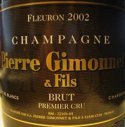 Gimonnet is a small grower, producer in Champagne who resides firmly in Chardonnay territory, making mostly Blanc de Blancs (100% Chardonnay). They are very pretty wines with a relatively low dosage. Made from vines in Cramant, Chouilly and Cuis, the Fleuron is one of his top wines. Of note, 2002 is an outstanding, but young, vintage in Champagne. The best wines, including this one, will only get better for many years and some are quite tight right now. Gimonnet is a small grower, producer in Champagne who resides firmly in Chardonnay territory, making mostly Blanc de Blancs (100% Chardonnay). They are very pretty wines with a relatively low dosage. Made from vines in Cramant, Chouilly and Cuis, the Fleuron is one of his top wines. Of note, 2002 is an outstanding, but young, vintage in Champagne. The best wines, including this one, will only get better for many years and some are quite tight right now.Pretty chalk, butter, dough and limoncello grace the nose and lead to a creamy textured wine with a lemon-butter acidity all underlined by a sophisticated chalky minerality. Complex and intense in flavor yet fine and aristocratic. Everything is in the right place here. This is just lovely but feels pretty tight and wound up at this point. I'd hide this in the cellar for at least a few more years before drinking it over the next couple decades. Bravo! Two Stars Plus. A Terry Theise Estate Selection. Importer: Michael Skurnik Wines, Syosset, NY. |
|||
| Pierre Gimonnet Special Club 1999 |
Drink Now-2019 | $65 | |
 There is a group of small producers in Champagne called the Club Trésors de Champagne. There are 26 members and each can submit special Champagnes to the club for judging. Those that pass the test are bottled in the unique bottle and called the "Special Club". There is much debate as to whether the Special Club Champagnes are worth the bit of a mark-up in price they usually come with. I think it varies but in this case, this Gimonnet is not as compelling a wine as the previous wine, the Fleuron. Maybe it is partially the vintage difference too. There is a group of small producers in Champagne called the Club Trésors de Champagne. There are 26 members and each can submit special Champagnes to the club for judging. Those that pass the test are bottled in the unique bottle and called the "Special Club". There is much debate as to whether the Special Club Champagnes are worth the bit of a mark-up in price they usually come with. I think it varies but in this case, this Gimonnet is not as compelling a wine as the previous wine, the Fleuron. Maybe it is partially the vintage difference too.Pretty and flirtatious, lemon-butter, cream and flowers. Silky and goes down really easily. Enough complexity of creamy and silky flowers to keep it interesting. Somehow just doesn't have the extra "umph" to make it really memorable though. This is a good Champagne, but not a great one. For my money I prefer the Fleuron above. One Star Plus. A Terry Theise Estate Selection. Importer: Michael Skurnik Wines, Syosset, NY. |
|||
| Tintero Moscato d'Asti Sori' Gramella 2007 |
Drink Now-2010 | $10 | |
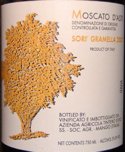 Good Moscato d'Asti is so much fun. Few wines are most scrumptious yet unassuming and easy. There is no better way to just have fun than with a cool glass of Moscato. While all cheap, there are tons that are watered down, overly sweet and just awful. This is one of the very good ones and worth every penny and more. Good Moscato d'Asti is so much fun. Few wines are most scrumptious yet unassuming and easy. There is no better way to just have fun than with a cool glass of Moscato. While all cheap, there are tons that are watered down, overly sweet and just awful. This is one of the very good ones and worth every penny and more.Enticing honey and rose petal aromas. Fun and refreshing flavors of sweet honey, rose and mint. Delicious and simply fun. Great alone just to celebrate life but it also shines with spicy food. At this price this is a definite winner. One Star Plus. Importer: Kermit Lynch Wine Merchant, Berkeley, CA. |
|||
White Wines:
| Bret Brothers Pouilly-Fuissé 2006 Cuvée Terres de Fuissé |
Drink 2011-2020 | $36 | |
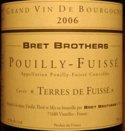 The Mâconnais region in southern Burgundy is a great source for inexpensive whites made from Chardonnay. While the famous white Burgundies from the Côte d'Or up north can go for hundreds of dollars a bottle, even the best from the Mâcon are generally under $50. The Bret Brothers made several excellent wines in 2006. Another was reviewed in Issue 13. The Mâconnais region in southern Burgundy is a great source for inexpensive whites made from Chardonnay. While the famous white Burgundies from the Côte d'Or up north can go for hundreds of dollars a bottle, even the best from the Mâcon are generally under $50. The Bret Brothers made several excellent wines in 2006. Another was reviewed in Issue 13.This wine is a bit more serious and young. Ripe, but chalk and granite-infused, fruits are shimmering and pristine, yet quite young and primary. Lush yet solid. Fine, powdered chalk runs the length of it, giving this wine a lovely caressing texture. Poised and elegant, yet very young and holding a lot in reserve. With air, this puffed up its feathers to show more fruit but also more of that core of stony minerality. This definitely seems to need more time than the Viré-Clessé Climat "La Verchère" which I reviewed in the last issue. I'd leave this in the cellar a few years or more and then enjoy over the subsequent decade. If you are going to drink it now, I'd recommend decanting it or at least opening it early to give it time to unfold and show its stuff. Two Stars. Becky Wasserman Selection. Importer: Cellar Door Imports, Woodland Hills, CA. |
|||
| d'Epiré Savennières Cuvée Spéciale 2006 |
Drink 2011-2020 | $20 | |
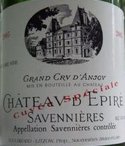 Savennières is definitely one of the hidden gems of the white wine world. d'Epiré is an excellent traditional producer. The Cuvée Spéciale is a blend of their best plots and old vines. Savennières is definitely one of the hidden gems of the white wine world. d'Epiré is an excellent traditional producer. The Cuvée Spéciale is a blend of their best plots and old vines.Spiced apple sauce was all I could coax out of the nose initially. This seemed quite shy and wound up just showing hints of fruit and a dusting of chalky minerals. Tart apple, pear and even some crisp honeydew melon. This is quite linear and wound up. It seems to have stuffing there but is just not showing any of it right now, rather showing very young and primary. I had a hard time evaluating this because it is so shut down. I left about half the bottle till the next night and it was better, a bit more open and integrated but still tight. This definitely needs a few years and if it fleshes out and gains in complexity with that time in bottle, my score may be quite conservative. However, I have questions that this will ever be a truly profound Savennières. That being said, I hold Savennières to a high standard, and for this price it is a nice wine by any standard. One Star Plus (with a question for the future). Importer: Kermit Lynch Wine Merchant, Berkeley, CA. |
|||
| Destino Vinos & Bodegas Gallegas |
Drink Now-2011 | $7 | |
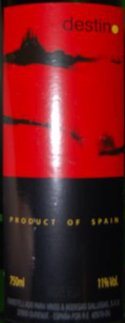 I couldn't find too much info about this white from Spain. I don't know the grape variety make up unfortunately. However, you don't need to know much to appreciate this fresh and lively inexpensive wine. Simple fresh Sauvignon Blanc-like fruits and hints of hay on the nose lead to a shimmering wine, like a mouthful of sun! Fresh and grassy. Simple but thrilling and refreshing. This is an outstanding dry, bright white to drink as an apéritif or as an accompaniment to a first course of fish or light cheeses. Great inexpensive value. One Star. Importer: Vitis Imports, Inglewood, CA. I couldn't find too much info about this white from Spain. I don't know the grape variety make up unfortunately. However, you don't need to know much to appreciate this fresh and lively inexpensive wine. Simple fresh Sauvignon Blanc-like fruits and hints of hay on the nose lead to a shimmering wine, like a mouthful of sun! Fresh and grassy. Simple but thrilling and refreshing. This is an outstanding dry, bright white to drink as an apéritif or as an accompaniment to a first course of fish or light cheeses. Great inexpensive value. One Star. Importer: Vitis Imports, Inglewood, CA. |
|||
| Château Ferrande Graves 2006 |
Drink Now-2012 | $20 | |
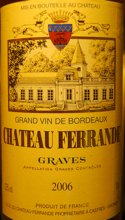 Graves is one of the most famous regions in Bordeaux for white wines. Graves is one of the most famous regions in Bordeaux for white wines.This one shows some of the classic aromas and flavors of Sauvignon Blanc, including lemon, hay, grass and gooseberry. Even a hint of flintiness. However, this isn't terribly deep or complex. Just a pleasant, simple, fresh and lightly fruity white. One Star. Importer: Nicolas, Westport, CT. |
|||
| von Schubert Maximin Grünhauser Herrenberg Kabinett 2006 |
Drink Now-2016 | $17 | |
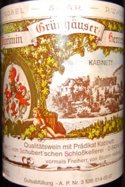 It is no secret that I love von Schubert's wines from Maximin Grunhaus. This classic, traditional estate in Germany makes some of the most transparent and classic expressions of Riesling. Their 06's are great across the board. It is no secret that I love von Schubert's wines from Maximin Grunhaus. This classic, traditional estate in Germany makes some of the most transparent and classic expressions of Riesling. Their 06's are great across the board.This Kabinett from the Herrenberg vineyard is lovely. Mango, lemon, lemon seeds and just a hint of smokey slate on the nose. Then put it in your mouth...its like the best lemonade you've ever had! Sweet lemon, orange and orange blossom perfume given life and clarity with fresh lemon/lime acidity and a tingle of white minerals. Very nice, classic Kabinett which is not heavy or overly ripe as many of today's Kabinetts can be. Two Stars. |
|||
Red Wines:
| Baudry Chinon Le Clos Guillot 2006 |
Drink 2012-2019 | $22 | |
 Baudry is currently one of the Loire Valley's best producers of red wines. His Chinons, made mostly from Cabernet Franc, are outstanding. It is quite an education in Chinon to taste through his lineup of various vineyards, each showcasing different characteristics. The transparency and expression of terroir is remarkable. I should note that last vintage, the 2005's, were absolutely stunning in Chinon. I reviewed the stunning 2005 Le Clos Guillot in Issue 6. Baudry is currently one of the Loire Valley's best producers of red wines. His Chinons, made mostly from Cabernet Franc, are outstanding. It is quite an education in Chinon to taste through his lineup of various vineyards, each showcasing different characteristics. The transparency and expression of terroir is remarkable. I should note that last vintage, the 2005's, were absolutely stunning in Chinon. I reviewed the stunning 2005 Le Clos Guillot in Issue 6.2006 does not seem to as quite a complete vintage as 2005 in Chinon. However, the wines are excellent, if not as outstanding as the 05s. The first thing I'll note about this 06 is that there is a bit more of the vegetal character that can sometimes characterize Cabernet Franc. That being said, the nose is lovely with pretty, shifting aromas of powdered sugar dusted berries, leg of lamb and Indian spices. Quite fine and contemplative. Initially, this was a bit hard to evaluate as it showed primarily green olive, bay and earth notes in the mouth. Definitely more streamlined and less ripe than the 2005. However, as it sat in the glass subtle, tart red fruits expanded to grace the herb and spice notes with more buffering depth. Even seemed to get riper and richer with air. I'm gonna bet this is going to get better with more time in bottle. It is pretty fresh off the boat and I think this just needs time to flesh out. For now, my score is conservative but in a few years I wouldn't be surprised if this warrants two or more stars. Will never be as great as the nearly perfect 05, but this will be excellent and is an outstanding value for age-worthy red wine. One Star Plus (but will likely improve). Importer: Kermit Lynch Wine Merchant, Berkeley, CA. |
|||
| Bolero Montepulciano d'Abruzzo 2007 |
Drink Now-2012 | $10 | |
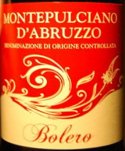 Ripe jammy black fruits with just enough meat and earth to make it serious and interesting. A pleasant dusting of ripe tannins and a hint of tangy acidity tie it together. This is an excellent simple table wine to enjoy with pizza, pasta or meat dishes. And better yet it is really inexpensive. One Star. Importer: Vitis Imports, Inglewood, CA. Ripe jammy black fruits with just enough meat and earth to make it serious and interesting. A pleasant dusting of ripe tannins and a hint of tangy acidity tie it together. This is an excellent simple table wine to enjoy with pizza, pasta or meat dishes. And better yet it is really inexpensive. One Star. Importer: Vitis Imports, Inglewood, CA. |
|||
| Clos la Coutale Cahors 2006 |
Drink Now-2016 | $16 | |
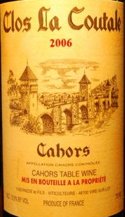 Cahors was once one of the most famous appellations in France, producing deeply colored, rich black wines primarily from Malbec, which is generally just a minor blending grape in nearby Bordeaux. For whatever reason they have fallen out of favor somewhat but the best producers still make excellent wines. The up side is that they are cheap is dirt! Clos la Coutale is one of the most widely imported in the US and one of the most highly regarded. It is made in this vintage from a blend of 80% Malbec and 20% Merlot. Cahors was once one of the most famous appellations in France, producing deeply colored, rich black wines primarily from Malbec, which is generally just a minor blending grape in nearby Bordeaux. For whatever reason they have fallen out of favor somewhat but the best producers still make excellent wines. The up side is that they are cheap is dirt! Clos la Coutale is one of the most widely imported in the US and one of the most highly regarded. It is made in this vintage from a blend of 80% Malbec and 20% Merlot.Dark black color. Hesitant blackberry liqueur and spice on the nose. As expected, this has dark, meaty black fruit with a bit of Merlot for roundness. However, this is currently quite simple and monolithic. Deep earthiness and tannin dust on the finish gives it focus and depth to the ripe blackberry jam fruit. But again, while rich, this lacks interest. Would make a good foil for some rich, meaty food. For the price, this is still a good buy if you need something dark and rich for your table, but I've had better vintages of Clos la Coutale. One Star. Importer: Kermit Lynch Wine Merchant, Berkeley, CA. |
|||
| J. Puffeney Arbois Poulsard 2005 |
Drink Now-2024 | $24 | |
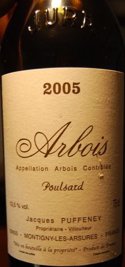 Puffeney is one of the old guard in France's Jura. Known most famously for his outstanding whites, in particular his passionate Vin Jaune (reviewed in Issue 12), he also makes beautiful, natural reds made from Pinot Noir, Poulsard and Trousseau. This one is his Poulsard, a grape grown widely in the Jura. Puffeney is one of the old guard in France's Jura. Known most famously for his outstanding whites, in particular his passionate Vin Jaune (reviewed in Issue 12), he also makes beautiful, natural reds made from Pinot Noir, Poulsard and Trousseau. This one is his Poulsard, a grape grown widely in the Jura.The color here is striking, light, ruby red, translucent and shimmering. The nose of this wine is intriguing. Initially I get spiced cherry Jolly Rancher fruit with herbs and warming Chambord liqueur. But then it almost seems like a paradox. On the one hand happy, easy sweet red fruits and spice. But then there is also a suggestion of something darker, sinister even, lurking in the depths. There is a similar impression on the palate but with more structure and tannin than you might expect from the light color. A dusty, chewy rustic tannin yet finely overlayed with bright, clear cherry and cranberry fruit with quite high acidity. Vibrant and full of personality, but subtle and primary in flavor. This is quite tightly wound. This is not a wine for everybody. If you crave big, chewy, sweet fruit "fruit bombs" stay far, far away! If you love cool climate wines with personality, transparency and a natural vibrancy to them this is fascinating wine. You could enjoy this now with food but I'd be inclined to hold this for 5 years or so to settle down and unwind a bit and then enjoy it over the subsequent decade. Two Stars. Importer: Rosenthal Wine Merchant, New York, NY. |
|||
| Solar de Estraunza Rioja Gran Reserva 1999 |
Drink Now-2024 | $37 | |
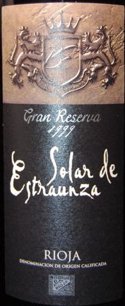 In Spain's Rioja, to be called a Gran Reserva a wine must have been aged in the producers cellar at least 5 years, two or more in barrel and the rest in bottle. Generally the idea is only to use this extended aging treatment to the best wines from the best vintages, although this is not regulated in any way. I love great Rioja but had never had this producer's wines and was very pleasantly surprised. In Spain's Rioja, to be called a Gran Reserva a wine must have been aged in the producers cellar at least 5 years, two or more in barrel and the rest in bottle. Generally the idea is only to use this extended aging treatment to the best wines from the best vintages, although this is not regulated in any way. I love great Rioja but had never had this producer's wines and was very pleasantly surprised.If you don't give this wine some time, you are going to miss what it really has to say. I say that because when I first popped and poured this wine it was pretty but it showed primarily oak influences, too much for my taste actually. Toasty and perfumed herbs and spice tending toward the American oak spectrum with a hint of dill. But also some pretty rose, spice and fragrant fruit blossoms too. The mouthfeel was a tad chunky and tannic although quite richly flavored too. This initial impression didn't last long though. When I came back to this wine after being open a couple hours a miraculous evolution had occured! The aromas mellowed, the oak integrated, disappeared really and just showed more and more floral, earthy and spicy Tempranillo fruit. The flavors woke up and matured too, becoming velvety but with palate staining intensity of vibrant, rich, ripe fruit. This is quite powerful, deep and long. If you drink this now, enjoy it slowly or decant it to give it some time to wake up and integrate. Otherwise, hold on to a few bottles for a few years. Very nice Two Stars. Importer: Vitis Imports, Inglewood, CA. |
|||

Have a Reader Tip or a Question? Contact Me!
Looking for Wine or Wine Tasting Related Info? Search our site!
Search This Site
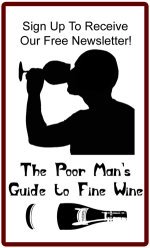
Site Sponsors

Peter Liem's
Champagne Guide

World's Best Grilling eBook!
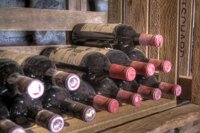 When some of us are first seduced by wine, one of the things that fascinates us is its mystery and romance. How can an agricultural product be so transformed into such a living thing, so full of character? And how is it that many of the best wines can age decades, changing and improving along the way? Amazed by this, many of us start collecting wine and laying bottles down in a cool place, waiting and expecting some magic to happen. Hoping that we will open these bottles in 5, 10, even 20, years and they will be glorious, wine epiphanies.
When some of us are first seduced by wine, one of the things that fascinates us is its mystery and romance. How can an agricultural product be so transformed into such a living thing, so full of character? And how is it that many of the best wines can age decades, changing and improving along the way? Amazed by this, many of us start collecting wine and laying bottles down in a cool place, waiting and expecting some magic to happen. Hoping that we will open these bottles in 5, 10, even 20, years and they will be glorious, wine epiphanies.
